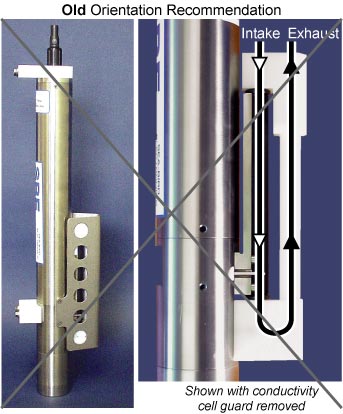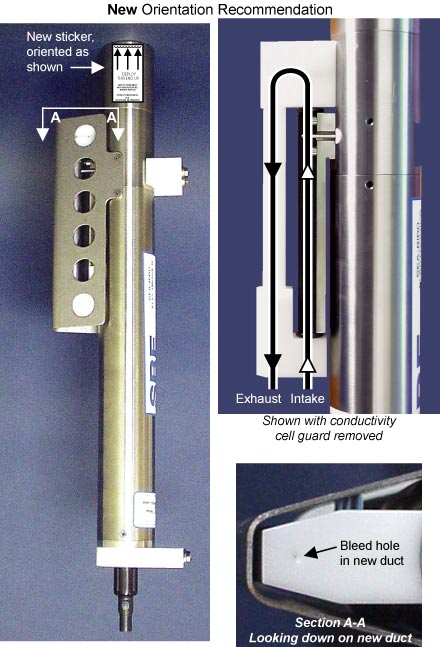FIELD SERVICE BULLETIN NO. 11
 Retrofit for MicroCATs with Integral
Pumps (37-IMP, 37-SMP, 37-SIP)
Retrofit for MicroCATs with Integral
Pumps (37-IMP, 37-SMP, 37-SIP)
December 2006

 Print version
Link to all Field Service Bulletins
Print version
Link to all Field Service Bulletins
Equipment Affected
All 37-IMP,
37-SMP,
37-SIP MicroCATs shipped before
mid-December, 2006.
Note: This Field Service Bulletin does
not apply to MicroCATs without an integral pump (SBE 37-IM, 37-SM,
37-SI).
Description of Problem
|
When deployed near the sea bottom or in very turbid
waters, pumped MicroCATs oriented with the intake/exhaust plumbing in an upright
U-shape can become clogged with sediment. This results in poor flushing, causing
poor quality data.
Reversing the orientation by putting the intake/exhaust
plumbing pointing downward will prevent sediment from accumulating, but will
cause air to be trapped in the pump impeller housing, thus preventing the pump
from priming quickly at depths above approximately 30 meters. Trapped air could
result in poor data until the air eventually dissolves and allows the pump to
prime and normal flushing to begin.
|
 |
Solution
| Sea-Bird now recommends that the MicroCAT be oriented for
deployment with its intake / exhaust in an inverted U-shape, with the
intake/exhaust plumbing pointing downward. A minor design modification has been
implemented to allow trapped air to escape.
Sea-Bird is providing a replacement duct with a small air
bleed hole. The bleed hole allows any air in the plumbing to escape. Retrofit is
easy and simply requires:
- Replacing the old duct with a new one having the air
bleed hole.
- Removing the old orientation sticker and applying the
new one, with the MicroCAT oriented as shown here, and the arrows on the
sticker pointing up.
|
 |
Corrective Action by Sea-Bird
- MicroCATs shipped before mid-December 2006:
- Sea-Bird will install the new duct with air bleed hole and new orientation
sticker (at no charge) the next time the instrument is returned to Sea-Bird
for calibration or repairs.
- Alternatively, you can request that Sea-Bird send you the retrofit kit (at
no charge), PN 50420 Pumped MicroCAT Duct with Air Bleed Hole Retrofit Kit,
if you want to do the retrofit yourself before you are able to send the
MicroCAT in for calibration or other repairs. Replace the duct and the
orientation sticker.
- MicroCATs shipped in mid-December 2006 and later: The
new duct with air bleed hole and orientation sticker are already installed.
Background Information and Detailed Deployment
Recommendations
Background Information
The integral pump runs for 1/2 second each time the
MicroCAT takes a sample. This pumping scheme, combined with the plumbing’s
U-shape, provide the following advantages over a non-pumped system:
- Improved conductivity response – The pump flushes the
previously sampled water from the conductivity cell and brings a new water
sample quickly into the cell.
- Reduced biological fouling – Water does not freely flow
through the conductivity cell between samples, allowing the build-up of the
anti-foulant in the water held in the plumbing, and minimizing fouling.
We recognize from discussions with some customers that the
original recommendations for MicroCAT orientation allow the MicroCAT to trap too
much sediment. This problem occurs mostly in shallow coastal waters, near-bottom
moorings, or offshore plumes of large rivers.
Deploying in an inverted U-shape to reduce the
ingestion of materials presents a different challenge – how to eliminate air
from the system, so that the pump will prime and operate. In considering the
effect of air on the pump, it can be instructive to look at the amount of air in
the water column:
- Case 1: The top ~2 meters of the water column
may contain a continuous supply of bubbles injected into the system by
breaking waves. In this area, the ability to continuously eliminate air from
the system, throughout the deployment, is of prime concern.
- Case 2: The next ~30 meters of the water column
is not typically affected by bubbles from breaking waves. In this region, it
could take a few days to weeks after deployment for the air to clear out of
the system in an inverted U-shape. However, once the air is bled, no more air
would be injected into the plumbing.
- Case 3: Below ~30 meters, it could take only a
few hours to a day for the air to clear out of the system in an inverted
U-shape. As in Case 2, once the air is bled, no more air would be injected
into the plumbing.
To allow use of the MicroCAT in the inverted
U-shape, Sea-Bird has designed a new duct with a small air bleed hole, to
provide a way for the air to exit the plumbing. However, because the bleed hole
also provides a little more ventilation of the system, this ventilation will
cause a slight decrease in the concentration of anti-foulant in the water held
in the plumbing between samples. In our judgment, and the experience of
customers, the risk of poor data due to sediment accumulation is usually greater
than the risk of slightly reduced effectiveness of the anti-foulant, or is at
least a reasonable trade-off.
Recommendations for Deployment
- Most deployments – Using the new duct with air
bleed hole, deploy the MicroCAT on a mooring cable or structure with the
plumbing in an inverted U-shape, allowing air to exit the plumbing
through the bleed hole.
- Deployments where severe bio-fouling is the main
concern and sediment is not an issue –
Case A: You need accurate data
immediately upon deployment ‑
Do not retrofit your existing MicroCAT (alternatively, plug the bleed hole in
a MicroCAT that has been retrofitted). Deploy the MicroCAT with the plumbing
in an upright U-shape, providing maximum bio-foul protection but
leaving the MicroCAT vulnerable to ingestion of sediment.
Case B: You can skip some initial data, allowing time for trapped air to
dissolve into the water and the pump to prime properly – Do not retrofit your
existing MicroCAT (alternatively, plug the bleed hole in a MicroCAT that has
been retrofitted). Deploy the MicroCAT with the plumbing in an inverted
U-shape, providing maximum bio-foul protection as well as protection from the
ingestion of sediment. This deployment method will provide good data within a
day if the deployment is deeper than ~30 meters. Eliminate scans associated
with the initial deployment by evaluating the conductivity data; minimal
changes in conductivity are an indication that the pump flow is not correct
because air in the plumbing has prevented the pump from priming.
- Deployments where air bubbles are the main concern
and sediment is not an issue ‑ Do not retrofit your existing MicroCAT
(alternatively, plug the bleed hole in a MicroCAT that has been retrofitted).
Deploy the MicroCAT with the plumbing in an upright U-shape. This
orientation provides better bleeding of air from the plumbing than can be
achieved with the small bleed hole, but leaves the MicroCAT vulnerable to
ingestion of sediment.
Cleaning the Air Bleed Hole before each Deployment
The air bleed hole is 0.5 mm (0.02 inch) diameter. Clean
the air bleed hole before each new deployment, using a 0.4 mm diameter wire, 13
mm long (0.016 inch diameter wire, 0.5 inches long) (you can use #26 AWG wire).
Clean the hole and blow through it to ensure it is open and can vent trapped air
upon deployment.

Last modified:
26 Apr 2010
Sea-Bird Home Phone: (+1) 425-643-9866
Fax: (+1) 425-643-9954 E-mail:
seabird@seabird.com
![]() Retrofit for MicroCATs with Integral
Pumps (37-IMP, 37-SMP, 37-SIP)
Retrofit for MicroCATs with Integral
Pumps (37-IMP, 37-SMP, 37-SIP)![]()
![]() Print version
Link to all Field Service Bulletins
Print version
Link to all Field Service Bulletins

![]()